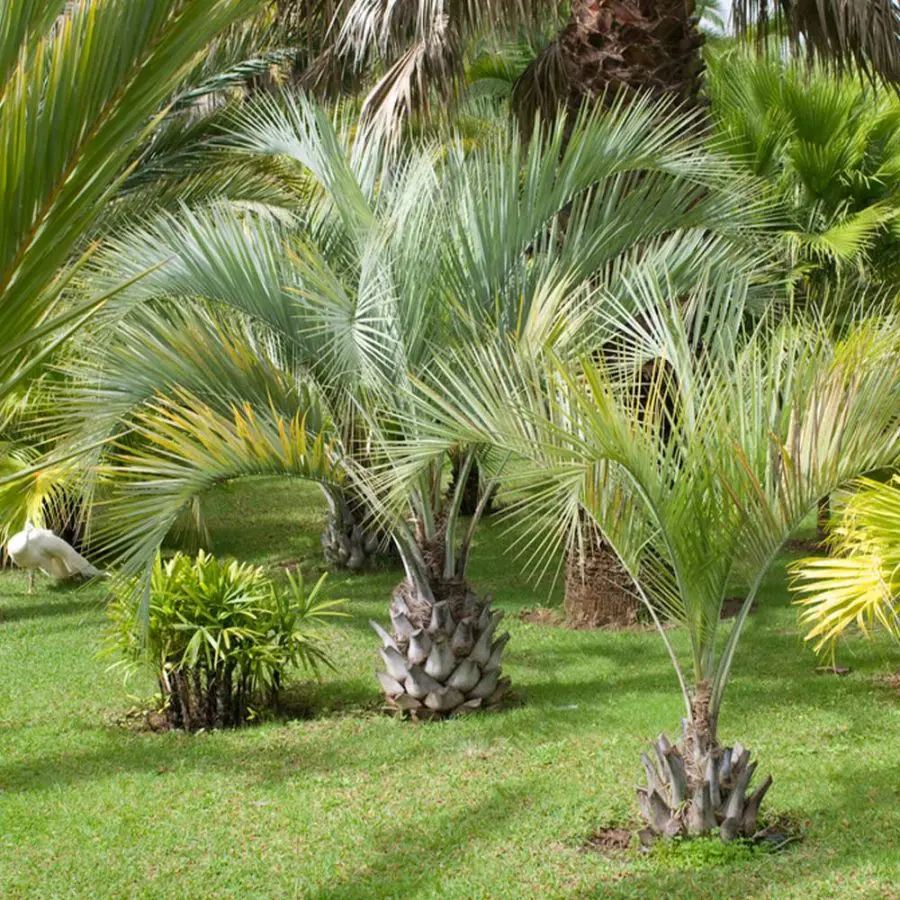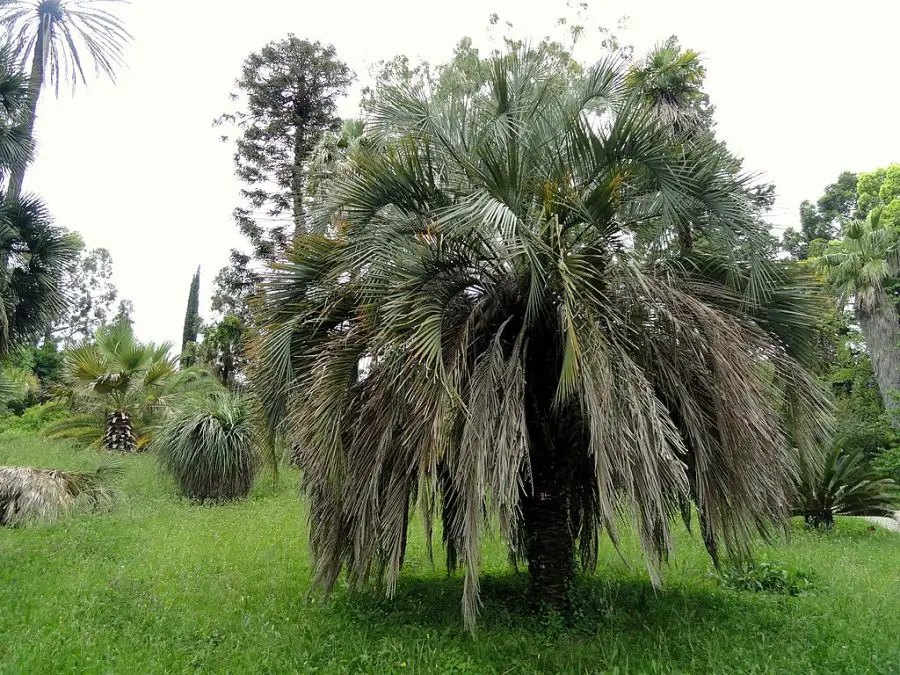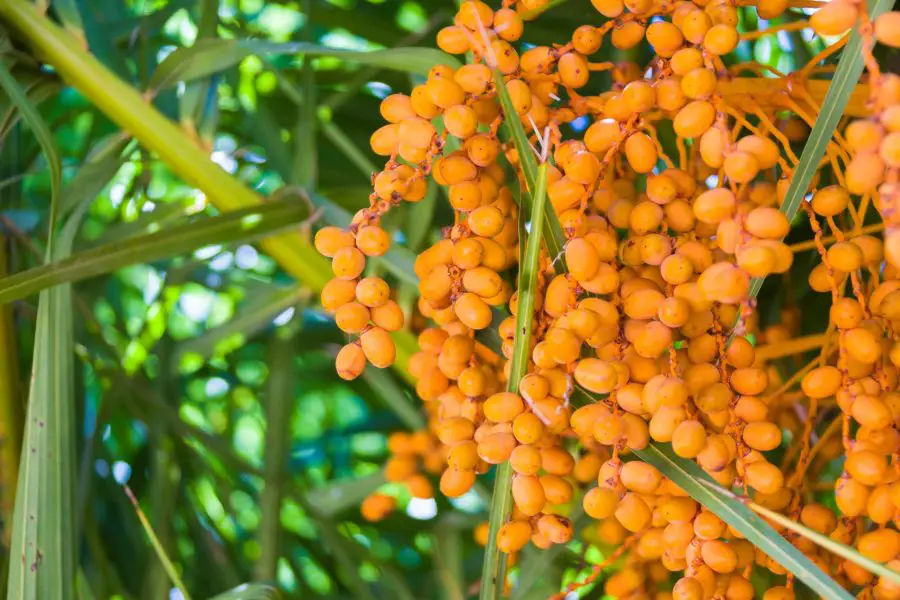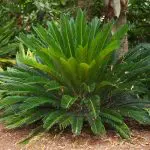This post contains affiliate links. If you buy something from one of our links we may earn a commission. Thanks

Get the green thumb in you excited with our Pindo Palm Care Guide! From soil to pruning, we cover everything you need for a thriving indoor palm.
Pindo Palm care requires a sunny location with well-draining soil. Water your palm regularly until established, then it’s drought-tolerant. Fertilize with a palm-specific fertilizer in spring, summer, and fall. Protect from cold winds and severe frost to maintain its attractive appearance and overall health.
Discover the secrets to lush, healthy Pindo Palms with our comprehensive Pindo Palm care guide.
Whether you’re a seasoned plant grower or a beginner, we’ve got you covered!
Are you ready to elevate your indoor gardening game? Look no further than our Pindo Palm Care Guide!
With its unique shape and beautiful foliage, the Pindo Palm tree is a fantastic addition to any living space and makes a great focal point for any room.
However, caring for this tropical plant requires some knowledge and attention.
Don’t worry, though – we’ve got all the tips and tricks you need to keep your Pindo Palm happy and healthy.
Pindo Palm Care Guide
Welcome, plant lovers! Are you looking to bring some tropical vibes into your home?
Look no further than the Pindo Palm – a gorgeous indoor plant that can add a touch of paradise to any room.
In this Pindo Palm Care Guide, we’ll walk you through everything you need to know to keep your plant thriving, from choosing the right pot to pruning and pest control.
So grab your gardening gloves and let’s get started on this green journey together!
What Is A Pindo Palm?

The Pindo Palm botanical name is Butia capitata. It is a slow-growing palm tree that is native to South America.
This species of palm is also known by the common name jelly palm, because of its sweet edible fruits that are used to make jelly.
On a single pindo palm tree, there exist distinct male and female flowers that grow on a lengthy spike.
During early summer, these flowers transform into bunches of eatable yellow to red fruits, similar in size to cherries.
However, in cooler climates, the fruit may not ripen. The Pindo Palm can grow up to 20 feet tall, but it is usually smaller when grown indoors.
It has long, feathery fronds that can add a tropical feel to any space.
According to Wikipedia: Butia capitata, also known as jelly palm, is a Butia palm native to the states of Minas Gerais and Goiás in Brazil.[4] It is known locally as coquinho-azedo or butiá in (northern) Minas Gerais.[5] This palm grows up to 8m (exceptionally 10m). It has feather palm pinnate leaves that arch inwards towards a thick stout trunk.
Pindo Palm Quick Facts
| Mature Height: | 15-20 ft |
| Mature Width: | 10-15 ft |
| Sunlight: | Full-Partial |
| Growth Rate: | Slow |
| Botanical Name: | Butia capitata |
| Grows Well In Zones: | 8-11 outdoors |

The pindo palm species is one of the cold hardiest palms and is known to survive temperatures as low as 5 degrees.
So they can be a good choice for keeping hardy palm trees outdoors in areas with mild winters.
You can buy your own Pindo Palm Tree here
Importance of Indoor Pindo Palm Care
While the Pindo Palm is a hardy plant that can survive in a variety of conditions, it still requires some care to thrive indoors.
Proper care will not only keep your Pindo Palm looking beautiful, but it can also help it live a longer, healthier life.
This plant can improve the air quality in your home by removing harmful toxins, and it can also add a touch of natural beauty to your space.
Brief Overview Of What Is Covered
This Pindo Palm Care Guide will cover everything you need to know to keep your indoor Pindo Palm healthy and happy.
We will cover the following topics:
A. Choosing the Right Pot and Soil
B. Light Requirements
C. Watering and Humidity
D. Temperature and Air Quality
E. Fertilizing and Pruning
F. Pests and Diseases
By the end of this guide, you will have all the information you need to become a Pindo Palm expert and keep your plant looking its best.
Choosing the Right Pot and Soil

When it comes to keeping your indoor Pindo Palm healthy, choosing the right pot and soil is key.
The right pot will provide your new tree with the proper drainage and support it needs, while the right soil will ensure it gets the right nutrients.
With so many pot and soil options out there, it can be overwhelming to choose the right one.
Don’t worry, though – we’ve got you covered!
In this section of our Pindo Palm Care Guide, we’ll provide you with everything you need to know to choose the perfect pot and soil for your indoor Pindo Palm.
Let’s get started!
Pot Size and Material
Choosing the right pot size and material is important for the health and growth of your indoor Pindo Palm.
A pot that is too small will restrict the growth of the roots and cause the plant to become root-bound.
On the other hand, a pot that is too large can lead to overwatering, soggy soil, and root rot.
Choose a pot slightly wider than the root ball.
The material of the pot is also important, as it affects the moisture retention and drainage of the soil.
Terra cotta pots are a popular option as they are porous and allow for air circulation, which helps prevent overwatering.
Soil Type and Quality
The type and quality of soil used for your indoor Pindo Palm is crucial for its growth and overall health.
Choose soil types that have good drainage to prevent waterlogging and root rot.
A good quality potting soil mixed with sand or perlite can provide the right balance of moisture and drainage for your Pindo Palm.
It is important to avoid using soil from your garden as it will compact heavily and can contain pests and diseases that can harm your indoor plant.
Using Coco Coir and Perlite and Why It’s Better than Peat Moss
Coco coir and perlite are becoming popular alternatives to traditional peat moss mixes.
I think they are the best way to pot up your palm tree. Coco coir is a renewable resource that is made from coconut husks and is an excellent soil amendment.
It improves drainage, provides good aeration, and has natural anti-fungal properties.
Perlite is a volcanic rock that is added to soil to improve drainage and aeration. It is also lightweight and helps prevent soil compaction.
Both of these options are environmentally friendly and can improve the overall health of your indoor Pindo Palm.
Importance of Proper Drainage
Proper drainage is crucial for the health of your indoor Pindo Palm.
Without proper drainage, the soil can become waterlogged, leading to root rot and other issues.
Ensure your pot has drainage holes to allow excess water to escape. It is also important to use a well-draining soil mix and avoid overwatering your plant.
A good rule of thumb is to let the top few inches of soil dry out before watering again.
Proper drainage is key to a happy and healthy Pindo Palm!
Light Requirements

If you want your indoor Pindo Palm to thrive, providing it with the right amount of light is crucial.
Light is one of the most important factors in a plant’s growth and can have a significant impact on its health.
However, with so many different types of indoor lighting available, it can be tricky to know exactly what your Pindo Palm needs.
In this section of our Pindo Palm Care Guide, we’ll provide you with everything you need to know about the light requirements for your indoor Pindo Palm.
So, let’s dive in and shed some light on this important topic!
Natural Light vs. Artificial Light
Pindo Palms are native to South America and they can handle full sun to partial shade.
Indoors they prefer bright, indirect sunlight. In the absence of natural light, you can use artificial lighting to provide the necessary light for your indoor Pindo Palm.
While natural light is always preferred, you can supplement it with artificial light if necessary.
Ideal Lighting Conditions
When it comes to lighting conditions for your indoor Pindo Palm, it’s all about finding the sweet spot.
Too little light can cause your plant to become leggy and weak, while too much light can lead to burnt leaves and stunted growth.
Ideally, your Pindo Palm should receive bright, indirect light for at least six hours a day.
However, if you notice your plant’s leaves are turning yellow, it may be receiving too much direct sunlight and needs to be moved to a shadier location.
Strategies for Maximizing Light Exposure
Maximizing light exposure is key to the health and growth of your indoor Pindo Palm.
If you don’t have access to natural light, you can use artificial light sources such as LED grow lights.
When positioning your plant, consider the orientation of your windows and try to place it near a south-facing window for maximum light exposure.
You can also rotate your plant regularly to ensure all sides receive equal amounts of light.
Finally, keep your plant clean by wiping its leaves with a damp cloth regularly.
This will ensure the maximum amount of light is absorbed by the leaves and not blocked by dust and debris.
With these strategies, you’ll be sure to give your Pindo Palm the light it needs to thrive!
Watering and Humidity
Keeping your Pindo Palm healthy and happy also means giving it the right amount of water and humidity.
Overwatering or underwatering can have adverse effects on your plant’s health, so it’s essential to find the right balance.
Additionally, Pindo Palms require specific levels of humidity to grow correctly, and getting it right can make all the difference.
In this section of our Pindo Palm Care Guide, we’ll cover everything you need to know about watering and humidity to ensure your indoor Pindo Palm is always looking its best.
Let’s dive in and quench your thirst for knowledge!
Watering Frequency and Amount
One of the most important things to get right when it comes to Pindo Palm care is watering.
Overwatering or underwatering can cause serious damage to your plant. As a general rule, Pindo Palms require moderate watering.
It’s essential to ensure that the soil is evenly moist and doesn’t dry out completely between watering.
When watering your plant, give it enough water to thoroughly saturate the soil.
You can check whether the soil is dry by sticking your finger about an inch into the soil. If it feels dry, it’s time to water your plant.
How to Determine When to Water
It’s easy to get caught up in a watering routine, but it’s essential to remember that every plant’s watering needs can vary.
Instead of sticking to a strict schedule, try to observe your Pindo Palm’s needs.
Signs that your plant needs watering include wilted or droopy leaves or dry soil.
Conversely, if you notice the leaves turning yellow or dropping, it may be a sign of overwatering.
Importance of Humidity and How to Increase It
Pindo Palms are native to humid environments, and as such, they require higher humidity levels to thrive.
Dry conditions can cause the plant’s leaves to turn brown and brittle, so it’s essential to maintain adequate humidity levels.
You can increase humidity around your Pindo Palm by using a humidifier or by placing a tray of water near the plant.
Alternatively, you can mist your plant’s leaves with water once a day to keep them moist.
With these tips, you’ll be sure to keep your Pindo Palm well-watered and hydrated.
Temperature and Air Quality
Pindo Palms are a popular indoor plant due to their hardy nature and unique appearance, but did you know that the temperature and air quality in your home can impact their growth?
In this section of our Pindo Palm Care Guide, we’ll be covering everything you need to know about maintaining the right temperature and air quality to keep your plant healthy and thriving.
From avoiding drafts to filtering the air, we’ve got you covered.
So sit back, relax, and let’s learn how to create the perfect environment for your Pindo Palm to flourish!
Ideal Temperature Range for Pindo Palms
Pindo Palms are a tropical plant and require a warm and humid environment to thrive.
Ideally, the temperature around your Pindo Palm should be between 65 and 85 degrees Fahrenheit.
Avoid exposing your plant to sudden cold temperatures or drafts, as these can cause damage to the leaves and stem.
Effects of Dry Air on the Plant
Dry air can have a detrimental effect on the health of your Pindo Palm.
It can cause the leaves to become dry and brittle, and the tips to turn brown.
Additionally, low humidity can cause the soil to dry out more quickly, leading to more frequent watering and potentially overwatering.
Strategies for Improving Air Quality
To maintain good air quality for your Pindo Palm, it’s important to reduce the amount of dust and pollutants in the air.
One way to achieve this is to use an air purifier or by placing the plant in a room with a good ventilation system.
Regularly dusting the leaves with a damp cloth can also help to keep the air around your plant clean.
If you live in a particularly dry climate, you can use a humidifier to increase the humidity levels in the air.
With these strategies, you’ll be sure to keep your Pindo Palm healthy and happy!
Fertilizing and Pruning

In this section of our Pindo Palm Care Guide, we’ll be discussing two essential aspects of plant care: fertilizing and pruning.
While Pindo Palms are known for their hardiness and resilience, it’s important to keep up with regular maintenance to ensure they reach their full potential.
In this section, we’ll be exploring how to fertilize your Pindo Palm for optimal growth and how to prune it to keep it looking tidy and healthy.
So, let’s dive into the world of fertilizers and pruning and learn how to keep our Pindo Palms thriving!
Types of Fertilizer to Use
Choosing the right fertilizer for your Pindo Palm is essential to promote healthy growth and maintaining the plant’s overall health.
Look for a slow-release, balanced fertilizer that contains nitrogen, phosphorus, and potassium.
Palms can suffer from micronutrient deficiencies so make sure to use a complete fertilizer that includes them.
Alternatively, you can use a palm fertilizer that’s tailored to the specific nutrient needs of the plant.
I like to use slow-release fertilizer in the form of tree spikes and it is an excellent choice that greatly simplifies fertilizing.
The use of tree spikes will take the guesswork out of fertilizing. Here is what I recommend for  fertilizing your Pindo Palm.
fertilizing your Pindo Palm.
I recommend using Jobes Organics fertilizer spikes.
They are easy to use and last for 2-3 months.
They are designed for container-grown citrus but they also work great for palm trees.
Using 2 spikes for a 12-inch pot or 3 for an 18-inch pot takes the guesswork out of fertilizing.
They provide a 3-5-5 fertilizer blend along with micronutrients and beneficial bacteria.
How Often to Fertilize
The frequency of fertilization will depend on the specific fertilizer you’re using.
But generally, you’ll want to fertilize your Pindo Palm every three to four months during the growing season (spring and summer) for the best growth.
Tree spikes last about 3 months so you would add them in early spring and again in summer.
Be sure to follow the instructions on the fertilizer packaging carefully to avoid over-fertilizing, which can cause damage to the plant.
Tips for Pruning to Maintain Health and Appearance
Pruning your Pindo Palm is an essential part of maintaining its health and appearance.
Remove any yellowing or brown dead leaves to promote new growth and to prevent the spread of disease.
Cut off any dead or damaged fronds as well, but be careful not to remove too many healthy fronds, as this can weaken the plant.
If you’re pruning large palm fronds, use sharp, clean pruning shears and make a clean cut near the base of the frond to avoid damaging the trunk.
With these tips, your Pindo Palm will be looking its best in no time! The best time to prune is late spring as growth resumes.
Don’t remove healthy green fronds only remove damaged or dead fronds.
Pests and Diseases
Keeping your Pindo Palm healthy and free of pests and diseases is essential to ensure its longevity.
While Pindo Palms are generally quite hardy, they can be susceptible to a variety of pests and diseases, including spider mites, scale, and fungal infections.
In this section, we’ll cover the most common pests and diseases that can affect your Pindo Palm, as well as strategies for prevention and treatment.
By following these tips, you can help ensure that your Pindo Palm stays healthy and vibrant for years to come.
Common Insect Pests
Common pests that can affect Pindo Palms include spider mites, scale insects, and mealybugs.
These pests can cause damage to the leaves and weaken the overall health of the plant.
Symptoms of pest infestation
Symptoms of pest infestation include discolored or distorted leaves, webs or residue on the leaves, and stunted growth.
To treat an infestation, you can use a mild insecticidal soap or neem oil spray.
Be sure to follow the instructions carefully and avoid using harsh chemicals that can damage the plant.
Common diseases
Common diseases that can affect Pindo Palms include fungal infections such as Fusarium wilt and root rot.
These diseases can cause discoloration and decay of the leaves and stem, and in severe cases, can lead to the death of the plant.
To prevent these diseases, it’s important to maintain good hygiene practices such as cleaning pruning tools, and avoiding overwatering.
You can also use a fungicidal spray to prevent fungal growth.
If you suspect your Pindo Palm is affected by a disease, it’s best to consult a professional for treatment options.
Pindo Palm FAQs
Embarking on the journey of caring for a Pindo Palm can be an exciting venture.
However, there are common questions that may arise as you strive to ensure the best growth for your palm.
Below are some of these queries along with their answers to help ensure your Pindo Palm thrives:
Q. What type of soil is best for Pindo Palms?
A. Pindo Palms thrive in well-draining soil, as it helps prevent waterlogging and root rot, which are common issues.
You might want to consider a sandy loam or soil mixed with a good amount of organic matter. Coco coir and perlite are also a suitable mix, especially in pots.
Ensuring that the pH level of the soil is slightly acidic to neutral (6.1 to 7.8) can also contribute to healthier growth.
Q. How often should I water my Pindo Palm?
A. Initially, it’s advisable to water your Pindo Palm frequently to help it establish; this could mean watering every day or every other day during the first few weeks, particularly in warmer climates.
Once established, they are quite drought-tolerant. However, during prolonged dry spells, a deep watering every week or two will help keep it healthy.
Q. When should I fertilize my Pindo Palm?
A. Pindo Palms will benefit from a balanced, palm-specific fertilizer that contains essential nutrients and micronutrients.
It’s best to fertilize in the spring, summer, and fall. A slow-release fertilizer is a great choice as it provides nutrients over a longer period, supporting steady growth and lush foliage.
Q. How can I protect my Pindo Palm from cold weather?
A. While Pindo Palms are relatively cold hardy compared to other palm varieties, they do appreciate protection from severe frost and cold winds.
Planting them in a sheltered location, or providing a windbreak, can be beneficial. During unexpected frost or freezing temperatures, covering the palm with burlap or a frost cloth can provide additional protection.
It’s also wise to mulch around the base of the palm to help retain soil moisture and provide some insulation against temperature fluctuations.
In colder climates consider growing them in pots and move to a protected location or indoors during winter.
Pindo Palm Care Guide Conclusion
And that’s a wrap! Taking care of a Pindo Palm may seem like a daunting task, but with the right knowledge and strategies, you can keep your indoor palm healthy and thriving.
Remember to choose the right pot and soil, provide adequate lighting, water, and humidify properly, maintain a comfortable temperature and air quality, fertilize and prune when needed, and be on the lookout for pests and diseases.
By following these tips and tricks, you’ll be able to enjoy the natural beauty of your Pindo Palm for years to come. Happy gardening!
Final thoughts on care for indoor Pindo Palms:
Caring for indoor Pindo Palms may require some effort and attention, but the rewards of having a beautiful and healthy plant in your home are well worth it.
Not only do they add natural beauty to any space, but they also have air-purifying benefits and can help create a calming atmosphere.
So don’t be afraid to take on the challenge of Pindo Palm care – with the right tips and tricks, you’ll be able to enjoy a thriving plant for years to come. Happy gardening!
You can buy your own Pindo Palm Tree here
Learn more about growing palm trees indoors.







